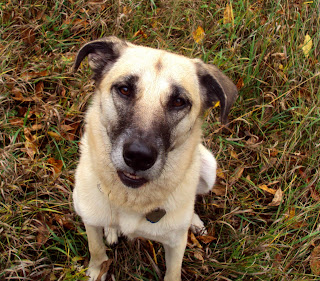ARE YOU DIRECTING OR ARGUING WITH YOUR DOG?
SO, YOU WANT TO INSTRUCT AND DIRECT YOUR DOG...
WELL, LET"S START BY DISCUSSING WHAT YOU SHOULD NOT DO!
DON’T ENGAGE IN AN ARGUMENT WITH YOUR DOG, DON'T
COMPLAIN & WHINE!
Tugging and pulling,
yelling, frustration, anger - it’s all part of engaging in an argument. If you are trying to provide direction to your
dog - who is excited, anxious, reactive and you are also excited, frustrated,
angry, reactive you are matching your dog’s state. You are most definitely
leading by example - the wrong example. Dogs don’t like hypocrisy any more than
humans do - would you follow someone who made no sense, lacked logic and was in
an emotional unbalanced state?
If you expect trouble
you will get trouble…your dog knows if you are anticipating an argument.
Be fair, but be determined, persistent, consistent and patient. Your dog knows when he has an edge
to manipulate and control.
Do not say
to your dog ‘would you just stop that!’ or I wish you would stop doing that’,
or ‘you are bothering me, quit it!’ If you do this you are not providing
direction, nor are you embracing the role of leader. You are whining and
complaining not providing direction! When we whine instead of direct, we give
our dog a choice - you can listen to me or not. Just like humans, most will
choose the ‘not’ option.
Think about it this
way…why do you feel like you will have to repeat yourself? Is it because you
are not confident in your ability to direct, is it because you realize you are
not in control of the situation? Dogs know when we vacillate, waiver, lack
confidence and commitment. Dogs can read our thoughts, our state of being by
observing our body language, our voice, our scent.
When we think ‘this
is going to be an argument’ and ‘I am going to have to repeat myself’, ‘my dog
is going to do what he has always done’…you are setting you and your dog up for
failure.
DOGS AND COMMUNICATION
A dog's sense of hearing and smell is much
more acute then ours. For most people our primary form of communication is
voice, but dogs rely on body language to consciously communicate much more than
humans do.
Dogs are very sensitive and use their senses (sight, scent sound) more keenly and consciously than people do. Dogs look at a human's face to understand, ask and engage the human.
When we think of something that makes us happy, unhappy, sad, angry, excited, etc. the thought translates to our body. We may tense our shoulders, clench our hand, narrow our eye, purse our mouth, change our breathing, sweating and so on. This is our physical reaction to our own thoughts...as translated to our bodies = body language.
Body language is a form of communication and
your dog takes notice - instantaneously…our dogs are often aware of what we
feel before we are.
This is just one reason why it is so important to learn to be aware of your own emotional state when you are communicating to and working with your dog.
You cannot hope to lead your dog in an
affective manner if are not aware of what you are projecting.
You will indeed lead - but not as you hoped to! The instant
you get emotional, you either lose your dog audience - meaning they will no
longer pay attention to the direction you are attempting to provide or you will
influence them to become reactive just as you are! If your dog is barking and
you are yelling at it to stop - well guess what...you are a hypocrite. Why?
Because you are barking too! Behaviour wise - never ask someone (including a
dog) to do what your not prepared to do your self!
Dogs are also very sensitive and aware of physical presence and how dogs and people occupy space.
This is how a dog herds other animals and sometimes people
too! It is also how a dog clams space. If your dog jumps on visitors and the
visitor pulls back - this is an invitation to the dog to move further into the
visitors space. If you yield space to the dog it will move into the space you
yield. Conversely, if you do not withdraw but instead move into the dog’s space
the dog will back away. If you hold a treat in your hand and put your hand up
high - the dog will see this as an invitation to move into your space and jump
for the treat. If you hold you hand at your side with calm confidence and ‘own’
the treat the dog will not move-in to take the treat unless you offer it to the
dog. If you calmly and confidently ‘occupy’ a doorway, a dog will not bolt through
in front of you.
So, if you want to better understand and work with your dog...train yourself to be aware of and in control of your emotional state, be aware of how you occupy space, learn to see when your dog is looking at you asking for direction and respond.
YOUR DOG WILL NOT RESPECT YOU IF YOU DO NOT EARN THEIR
RESPECT
Most dogs, will instinctively know
what they are being asked to do if they are communicated with and shown in
the right way at the right time and provided with the right tools to navigate
safely and confidently through situations.
If the dog’s guardian has not
learned how to read their own dog, is not
aware of their own emotions, tone, etc, at the time that they are interacting
with their dog - the message that they are trying to give their dog can end up
being completely different than what was desired. The impact of such
inadvertent mistakes in handling communication can be profound and
exponentially harmful.
Further to that, too many people
rely solely on ‘voice ‘to communicate with their dogs. People communicate to their dogs constantly via their own
state-of-being, position of their body, the scents arising from emotional
state. Dogs use their senses (sight, scent sound) more keenly and consciously
than people do. They read stress and emotion in people before a person is
even aware of how they themselves feel. A little tension in a persons shoulder,
clinching of a hand, tightness of the lips, narrowing or widening of the eyes,
change in breathing, sweating). Most people have not trained themselves and as
such are totally unaware that they are communicating all this information. The
impact of this is also far-reaching.
A dogs `natural kit-of-tools` for
communication - scent, sight, sound, their own
state of being, the position of their body (or parts thereof), touch and
voice is comprehensive. When a human does not know how to beneficially and
consciously use these tools to communicate & relies on voice only the
result on any dog, more so on a very sensitive dog, can be traumatic.
As humans we habitually
approach/react too often from a raw state of emotion – this is an approach that can instantaneously overwhelm
the more acute senses of a dog. I firmly believe that gaining an awareness of
how you as an individual have habituated this normal ‘modern-day human’
approach is key to having a better relationship with your dog.
Dogs require coaching as do their human guardians to support and enable the best in each other and their relationship. Dogs require that their humans be sensitive and aware Pack Leaders – not dominators. There is a profound difference between dominating your dog and providing it instead with the right type of Leadership to suit the dog as an individual and a breed.
Dogs require coaching as do their human guardians to support and enable the best in each other and their relationship. Dogs require that their humans be sensitive and aware Pack Leaders – not dominators. There is a profound difference between dominating your dog and providing it instead with the right type of Leadership to suit the dog as an individual and a breed.
The human's approach and investment of time and energy
into the dog-canine relationship can have an enormous impact on the dog's
psychological, adaptive, etc. development. Breed matters to some degree, but I
believe the over ridding factor is not breed it is the individual dog's access
to the right learning environment. Hey, much like it is for people too!
The expectation of many people is
that their dog will inherently respect them.
It is an erroneous expectation and assumption, based on a cultural belief
rather than on psychology and the reality of the situation. It is also the
first place where the human-dog relationship can really get off-track. When the
expectation is not fulfilled, the human can become upset, frustrated at best.
The negative impact on the psychological health of the dog can be profound.
First, you must understand a little of the psychology of humans and the psychology of dogs. To better understand, examine how you, as an individual accord respect to others. There are various levels of respect.
First, you must understand a little of the psychology of humans and the psychology of dogs. To better understand, examine how you, as an individual accord respect to others. There are various levels of respect.
Respect - Level 1: Common respect is really a type of courteously that we
give to people when we first encounter/meet them. If you have no prior
knowledge of the person and the person is non-threatening you are probably
going to be pleasant to them. But would you trust them with your health and
well being? Likely not. You would sit back, observe them & try to ‘pick-up’
some knowledge of their approach to situations, based on a rating system of
criteria that you set. As an example you would want to know if the person is
rationale and logical, capable and able to make good decisions. Are they kind
and caring? Do they have your best interests in mind or only theirs? Are the
decisions and actions that they take, considered and considerate or reactive
and based solely on excess emotion?
Respect - Level 2: If the person has met your criteria then you will accord
them the second level of respect. This type of respect moves beyond the realm
of common courtesy into a fundamental belief that this person is worthy of your
trust - that they can be expected to make decisions that will enable your
health & well being. This person can be trusted to lead you in the right
direction - this person is a leader. This level of respect must be earned. It
cannot be accorded by one person to another by means of force - the result would
be fear and/or servitude, not respect.
Now examine how a dog accords
respect; basically the same way a human would - as described above.
To obtain a Level 2 respect rating from your dog, you need
to show that you are a firm, but fair LEADER who can and will make the right
decisions at the right time in the right way. To do this, you need to be able
to 'read' your dog. You need to be able to understand what your dog requires.
You need to be aware of what you are really communicating to your dog and how
you are communicating. Your dog needs to know that you can lead and direct it
in a calm and confident manner in all facets of its life. When you have shown
your dog that you can do this - you have earned their full respect.
Here are some examples to help you better understand how this works…
Here are some examples to help you better understand how this works…
Your dog may always greet you calmly, but when it meets another person it may behave very differently. If a new person greats your dog in an overly excited manner, your dog may choose to greet this person in an excited manor - the new person has engendered this response. If another new person is nervous, your dog may shy away from this person, or may even bar his teeth at this person, give a low growl etc. The person who is nervous is insecure...this creates a situation were your dog has to consider if this person is unpredictable or trustworthy. Your dog shows great instinct as this person may make illogical decisions based on their own nervous, insecure state.
On the other hand, if a new person is calm, confident and kind your dog will sense this, it will observe the person, and depending on the strength of the persons confidence may almost instantaneously accord them a higher respect level.
I see this all the time in my client's dogs. The dog may
treat them very differently than it treats me. When I wake into a client's home
I start to earn their dog's respect right away. The dog may have a long record
of barking, running around and jumping on visitors...but when I walk in and
provide instruction to the dog right away (without using my voice) the dog
responds by calming down. The dog’s first instruction comes from my state of
being - I am calm, confident & I own the personal space directly around me
with my confidence - body & mind. This is the dog’s first instruction. I
may provide a small gesture with my hand - second part of the communication.
The dog’s people usually cannot even see what I have done, yet they are shocked
that their dog has suddenly sat down quietly or comes to greet me silently just
using their nose to sniff my legs. This is an example of how I can earn respect
in the space of seconds.
Having then met me, the dog may run through a doorway or
down the stairs in front of its 'master', it may pull its master on a walk, but
it will not do any of these things to me. It will wait for me to go through the
door, or down the stairs. It will walk beside or behind me, without any
instruction from me other than my own presence of mind (calm, confident). Why
because I earned the dogs respect. How, by instructing it, when I first walked
through that door in a way it was able to understand - something its own people
had never been able to do.
Dogs will respect those people who
have earned their respect. Other people will receive various levels of respect
or not from your dog according to how the people behave (emotional and
physical state)...that is basically how it works!
DIRECT YOUR DOG BY PROVIDING LEADERSHIP
PROVIDE A COMPLETE
DIRECTION TO YOUR DOG
Be prepared to
provide a full instruction. A full instruction consists of:
1. Getting your dogs
attention;
2. Letting your dog know what
you do not what him to do;
3. Letting your dog what
you do want him to do instead, and;
4. Following through
to correct your dog if he backslides into the unwanted behaviour.
The leadership role
is one of coaching and mentoring with fair, firm, clear direction. Never match
your dog’s state but you do have to match the intensity of his behaviour. I see
a lot of people doing only step 2. Then the poor dog gets in trouble as it goes
back to doing the unwanted behaviour as its human has not provided a full set
of instructions! Blame yourself, not your dog!
Holistic Diet, Nutrition, Wellness Services Tailored to Your Individual Dog and Cat
For information about my holistic diet, nutrition and wellness services, visit my holistic wellness services page.
Maintain good health | Address acute and chronic health issues | Pre and post surgery support and recovery
My holistic wellness services are available worldwide via video consultation.
🌎 USA | Canada | UK | Europe | Australia | New Zealand | Asia | South and Central America | Africa | UAE
📱FaceTime | Facebook | Skype | WhatsApp
To set-up your holistic wellness consultation get in-touch via email, go to my contact me page.
Holistic Behavioral Services for Your Dog
For information about my holistic behavioral services, visit my holistic behavioral services page.
For dogs of all ages, sizes and breeds.
My behavioral services are available worldwide via video consultation.
🌎 USA | Canada | UK | Europe | Australia | New Zealand | Asia | South and Central America | Africa | UAE
📱FaceTime | Facebook | Skype | WhatsApp
To set-up your holistic behavioral session get in-touch via email, go to my contact me page.
Affiliations to Companies
✓ None.
✓ I don't sell food, supplements, or other products.
✓ I'm not aligned with any companies.
Article and graphics by Karen Rosenfeld.






















